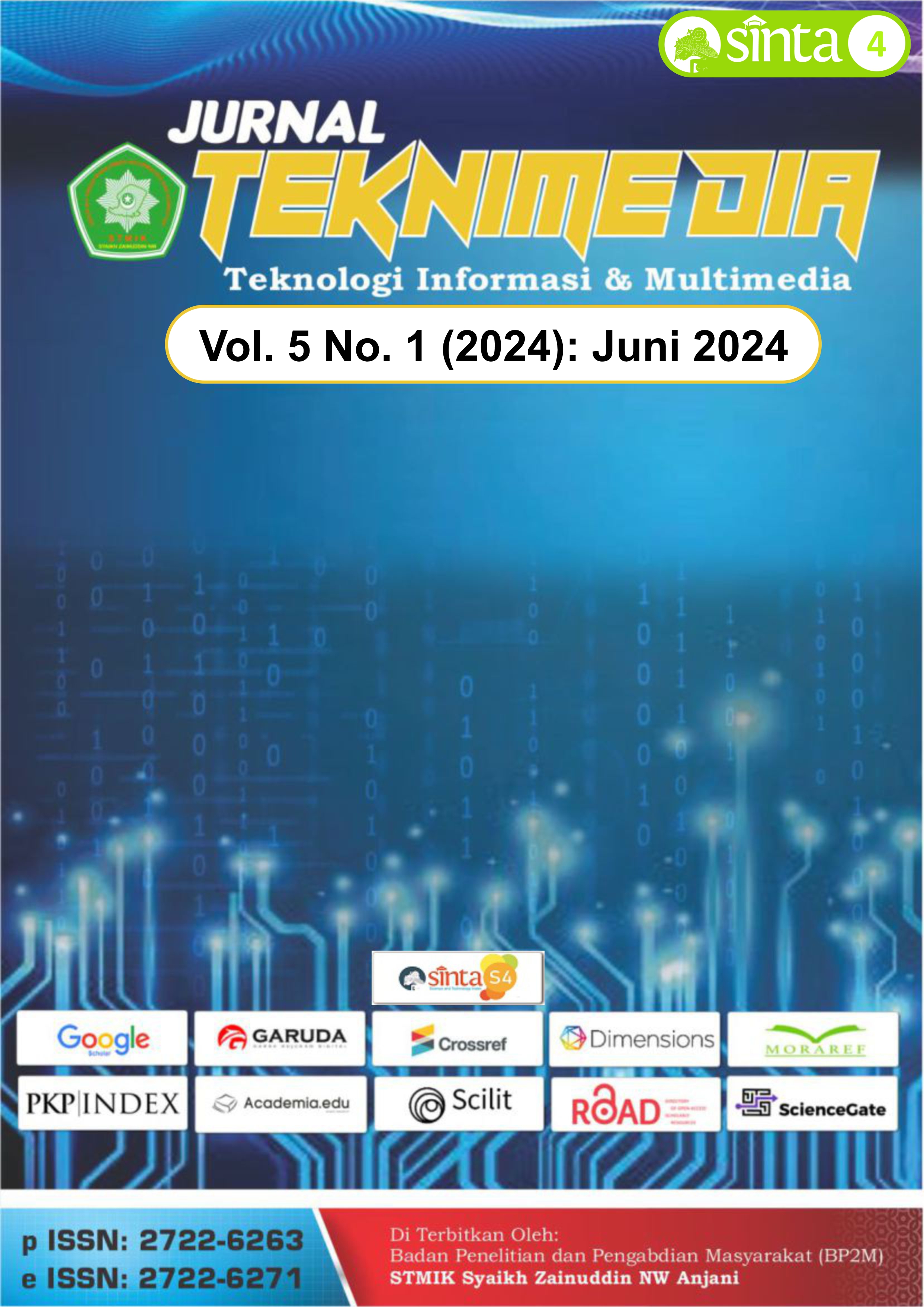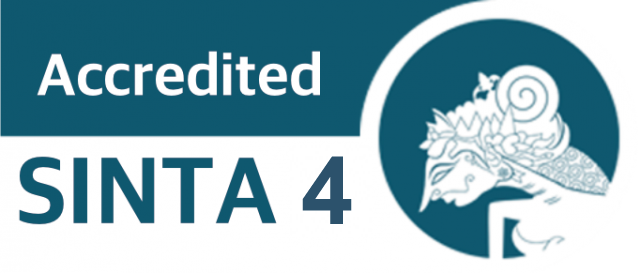PEMANFAATAN SAM DAN YOLOV8 UNTUK DETEKSI DAN SEGMENTATION MRI TUMOR OTAK
Abstrak
Perkembangan kecerdasan buatan (AI) terkhusus untuk bidang Computer Vision (CV) yang bertujuan untuk mendapatkan informasi berdasarkan data yang terdapat pada media visual seperti gambar, video, ataupun lainnnya. AI pada bidang kesehatan seperti pengenalan citra atau Deep Learning (DL) menjadi pembahasan yang sering dijadikan objek penelitian dan pengembangan. Keterbatasan di bidang kesehatan menjadi kemunculan pemanfaatan AI di bidang kesehatan sehingga mendorong penelitian DL dilakukan. Segmentation Anything Model (SAM) dan YOLOv8 merupakan algoritma baru yang diperkenalkan. Sehingga, penelitian ini bertujuan mengukur pemanfaatan SAM dan YOLOv8 untuk deteksi dan segmentasi pada data MRI Brain Tumor. Sebelum Proses training peneliti melakukan perbandingan segmentasi roboflow dan model SAM terlebih dahulu. Dataset dilabeling menggunakan Bounding Box oleh para ahli dari Hayatabad Medical Complex Peshawar. Dataset berisikan 455 glioma, 550 meningoma, 620 pituitary. Penelitian yang telah dilakukan menyimpulkan pemanfaatan SAM sangat mempermudah proses anotasi. YOLOv8 dengan task segmentasi mendapatkan hasil akurasi Box untuk semua kelas 86% presisi, 87% Recall, 89% mAP50 dan 71% mAP 50-95. Sedangkan evaluasi performa mask mendapatkan hasil 86% presisi, 87% Recall, 89% mAP50, dan 70% mAP50-95. Penelitian yang dilakukan mendapatkan model yang telah dilatih menggunakan YOLOv8n-seg mendapatkan hasil sangat baik meskipun merupakan model terkecil dari YOLOv8. Penelitian ini mendapatkan kelas tumor jenis glioma menjadi kelas dengan hasil yang terendah dikarenakan dataset yang digunakan tidak banyak. Disarankan untuk penelitian selanjutkan menggunakan data augmentasi untuk menambah penggunaan dataset setiap kelas. Sehingga memberikan hasil yang lebih baik.
Referensi
[2] A. I. B. Parico and T. Ahamed, “Real time pear fruit detection and counting using YOLOv4 models and deep SORT,” Sensors, vol. 21, no. 14, p. 4803, 2021.
[3] A. Ardiansyah and N. F. Hasan, “Deteksi dan Klasifikasi Penyakit Pada Daun Kopi Menggunakan Yolov7,” Jurnal Sisfokom (Sistem Informasi Dan Komputer), vol. 12, no. 1, pp. 30–35, 2023.
[4] D. I. Mulyana and M. A. I. Rowis, “Optimization of Text Mining Detection of Tajweed Reading Laws Using the Yolov8 Method on the Qur’an,” QALAMUNA: Jurnal Pendidikan, Sosial, dan Aga-ma, vol. 14, no. 2, pp. 1089–1110, 2022.
[5] A. J. London, “Artificial intelligence in medicine: Overcoming or recapitulating structural challenges to improving patient care?,” Cell Rep Med, vol. 3, no. 5, 2022.
[6] S. Reddy, “Explainability and artificial intelligence in medicine,” Lancet Digit Health, vol. 4, no. 4, pp. e214–e215, 2022.
[7] R. B. Parikh and L. A. Helmchen, “Paying for artifi-cial intelligence in medicine,” NPJ Digit Med, vol. 5, no. 1, p. 63, 2022.
[8] D. W. Putranto, Andi Sunyoto, and Asro Nasiri, “PEMANFAATAN DEEP LEARNING UNTUK SEGMENTASI PARU-PARU DARI CITRA X-RAY DADA,” TEKNIMEDIA: Teknologi Informasi dan Multimedia, vol. 4, no. 2, pp. 144–150, Dec. 2023, doi: 10.46764/teknimedia.v4i2.114.
[9] J. G. M. Esgario, R. A. Krohling, and J. A. Ventura, “Deep learning for classification and severity esti-mation of coffee leaf biotic stress,” Comput Elec-tron Agric, vol. 169, Feb. 2020, doi: 10.1016/j.compag.2019.105162.
[10] S. Lu, B. Wang, H. Wang, L. Chen, M. Linjian, and X. Zhang, “A real-time object detection algorithm for video,” Computers & Electrical Engineering, vol. 77, pp. 398–408, 2019.
[11] W. Fang, L. Wang, and P. Ren, “Tinier-YOLO: A real-time object detection method for constrained environments,” IEEE Access, vol. 8, pp. 1935–1944, 2019.
[12] I. Giannakis, A. Bhardwaj, L. Sam, and G. Leonti-dis, “A flexible deep learning crater detection scheme using Segment Anything Model (SAM),” Ic-arus, vol. 408, Jan. 2024, doi: 10.1016/j.icarus.2023.115797.
[13] A. Kirillov et al., “Segment anything,” in Proceed-ings of the IEEE/CVF International Conference on Computer Vision, 2023, pp. 4015–4026.
[14] S. J. A. Nugraha and B. Erfianto, “White Blood Cell Detection Using Yolov8 Integration with DETR to Improve Accuracy,” Sinkron: jurnal dan penelitian teknik informatika, vol. 8, no. 3, pp. 1908–1916, 2023.
[15] D. M. Toufiq, A. M. Sagheer, and H. Veisi, “Brain tumor identification with a hybrid feature extraction method based on discrete wavelet transform and principle component analysis,” Bulletin of Electri-cal Engineering and Informatics, vol. 10, no. 5, pp. 2588–2597, 2021.
[16] K. N. Qodri, I. Soesanti, and H. A. Nugroho, “Image analysis for MRI-based brain tumor classification using deep learning,” IJITEE (International Journal of Information Technology and Electrical Engi-neering), vol. 5, no. 1, pp. 21–28, 2021.
[17] N. M. Dipu, S. A. Shohan, and K. M. A. Salam, “Deep learning based brain tumor detection and classification,” in 2021 International conference on intelligent technologies (CONIT), IEEE, 2021, pp. 1–6.
[18] R. S. Passa, S. Nurmaini, and D. P. Rini, “YOLOv8 Based on Data Augmentation for MRI Brain Tu-mor Detection,” Scientific Journal of Informatics, vol. 10, no. 3, 2023.
[19] Y. Huang et al., “Segment anything model for med-ical images?,” Med Image Anal, vol. 92, Feb. 2024, doi: 10.1016/j.media.2023.103061.
[20] M. N. Sharma, “IMAGE AND VIDEO SEGMENTATION USING YOLO-NAS AND SEGMENT ANYTHING MODEL (SAM): MACHINE LEARNING,” International Research Journal of Modernization in Engineering Technol-ogy and Science, vol. 05, no. 10, 2023.
[21] Y. Liu, Y.-H. Wu, P. Wen, Y. Shi, Y. Qiu, and M.-M. Cheng, “Leveraging Instance-, Image- and Dataset-Level Information for Weakly Supervised Instance Segmentation,” IEEE Trans Pattern Anal Mach In-tell, vol. 44, no. 3, pp. 1415–1428, Mar. 2022, doi: 10.1109/TPAMI.2020.3023152.
[22] A. Kumar, “Study and analysis of different segmen-tation methods for brain tumor MRI application,” Multimed Tools Appl, vol. 82, no. 5, pp. 7117–7139, Feb. 2023, doi: 10.1007/s11042-022-13636-y.
[23] M. M. Chanu, N. H. Singh, C. Muppala, R. T. Prabu, N. P. Singh, and K. Thongam, “Computer-aided de-tection and classification of brain tumor using YOLOv3 and deep learning,” Soft comput, vol. 27, no. 14, pp. 9927–9940, 2023.
[24] B. Selcuk and T. Serif, “Brain Tumor Detection and Localization with YOLOv8,” in 2023 8th Interna-tional Conference on Computer Science and Engi-neering (UBMK), IEEE, 2023, pp. 477–481.
[25] S. He et al., “Computer-vision benchmark segment-anything model (sam) in medical images: Accuracy in 12 datasets,” arXiv preprint arXiv:2304.09324, vol. 3, 2023.
[26] S. Sarker, A. Biswas, N. M. A. Al, M. S. Ali, S. Pup-pala, and S. Talukder, “Case Studies on X-ray Im-aging, MRI and Nuclear Imaging,” Data Driven Ap-proaches on Medical Imaging, pp. 207–225, 2023.
[27] K. Priyadharshini, P. Krishnamoorthy, B. S. Ga-napathy N, K. Karthikeyan, U. M. S, and R. Ped-daveni, “Artificial Intelligence Assisted Improved Design to Predict Brain Tumor on Earlier Stages us-ing Deep Learning Principle,” in 2023 Annual Inter-national Conference on Emerging Research Areas: International Conference on Intelligent Systems (AICERA/ICIS), IEEE, Nov. 2023, pp. 1–6. doi: 10.1109/AICERA/ICIS59538.2023.10420011.
[28] T. A. Soomro et al., “Image Segmentation for MR Brain Tumor Detection Using Machine Learning: A Review,” IEEE Rev Biomed Eng, vol. 16, pp. 70–90, 2023, doi: 10.1109/RBME.2022.3185292.
[29] A. Ahmed and K. M. Hamza, “Labeled MRI brain Tumor dataset,” Kaggel. Accessed: Feb. 14, 2024. [Online]. Available: https://www.kaggle.com/datasets/ammarahmed310/labeled-mri-brain-tumor-dataset
[30] P. Skalski, “How to Use the Segment Anything Model (SAM). Roboflow Blog,” roboflow. Ac-cessed: Mar. 14, 2024. [Online]. Available: https://blog.roboflow.com/how-to-use-segment-anything-model-sam/
[31] G. Jocher, A. Chaurasia, and J. Qiu, “Ultralytics YOLOv8.” 2023. [Online]. Available: https://github.com/ultralytics/ultralytics
[32] R. Bai, M. Wang, Z. Zhang, J. Lu, and F. Shen, “Au-tomated Construction Site Monitoring Based on Improved YOLOv8-seg Instance Segmentation Al-gorithm,” IEEE Access, vol. 11, pp. 139082–139096, 2023, doi: 10.1109/ACCESS.2023.3340895.
[33] B. Gouila, “Instance Segmentation for Rock Particle Quality Monitoring: Integration of Deep Learning for Machine Vision Application in the Aggregates Industry,” 2024.
[34] A. M. Hafiz and G. M. Bhat, “A survey on instance segmentation: state of the art,” Int J Multimed Inf Retr, vol. 9, no. 3, pp. 171–189, Sep. 2020, doi: 10.1007/s13735-020-00195-x.
##submission.copyrightStatement##
##submission.license.cc.by-sa4.footer##Semua tulisan pada jurnal ini menjadi tanggungjawab penuh penulis. Jurnal Teknimedia memberikan akses terbuka terhadap siapapun agar informasi dan temuan pada artikel tersebut bermanfaat bagi semua orang. Jurnal Teknimedia dapat diakses dan diunduh secara gratis, tanpa dipungut biaya, sesuai dengan lisensi creative commons yang digunakan.

Jurnal TEKNIMEDIA : Teknologi Informasi dan Multimedia is licensed under a Lisensi Creative Commons Atribusi-BerbagiSerupa 4.0 Internasional


.png)





